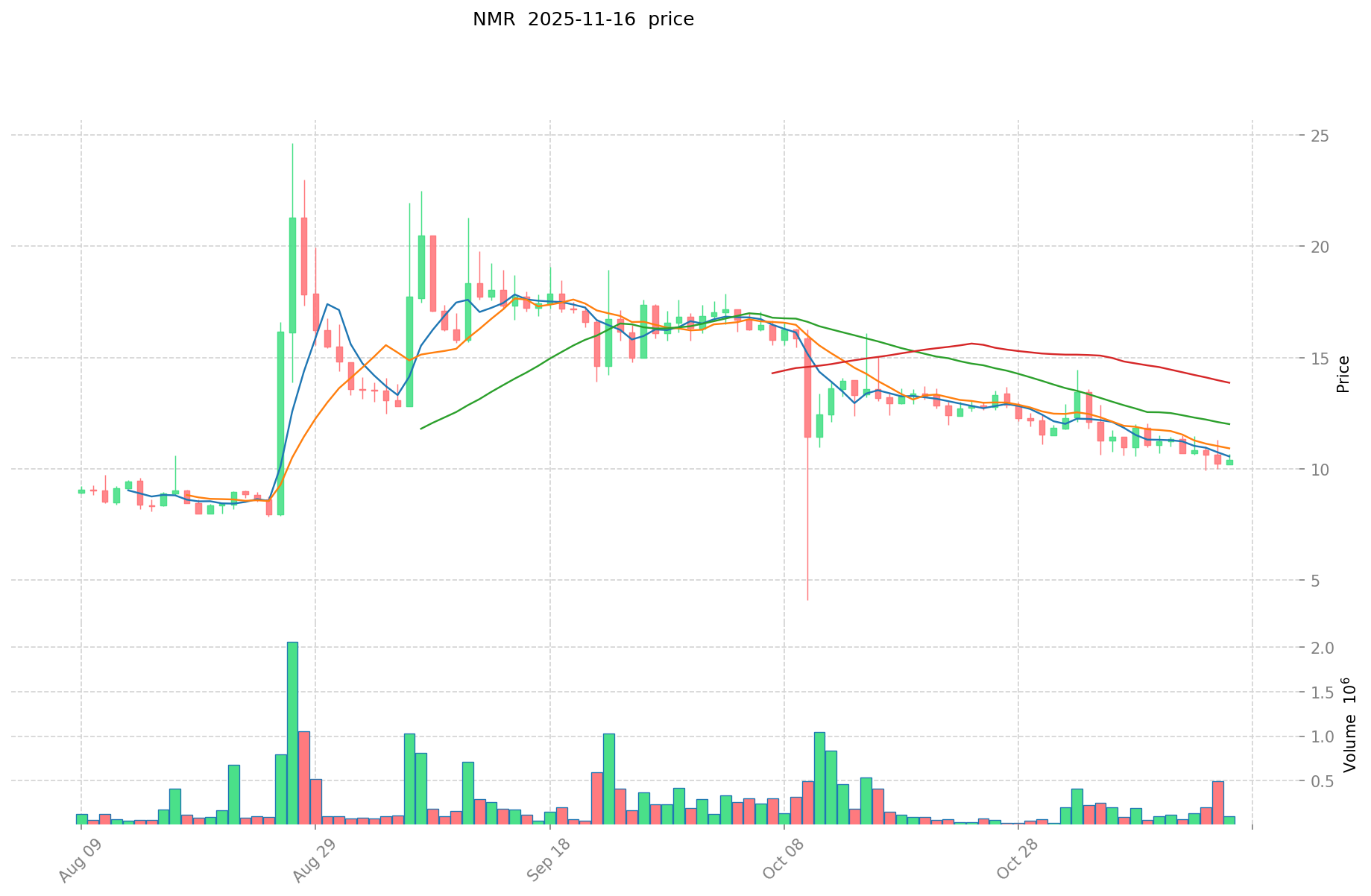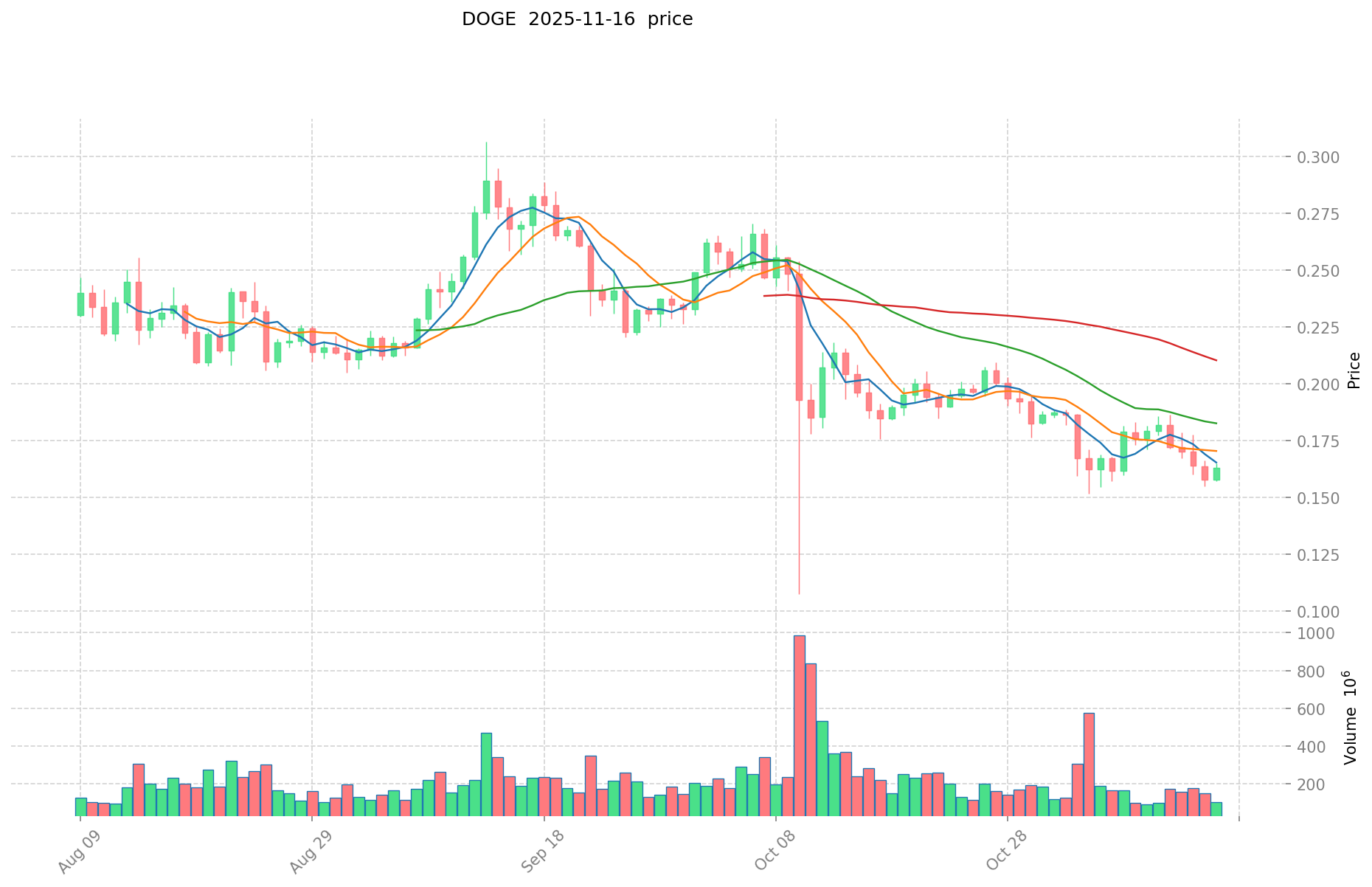NMR vs DOGE: Comparing the Performance and Potential of Two Cryptocurrencies in the Evolving Digital Asset Landscape
Introduction: Investment Comparison between NMR and DOGE
In the cryptocurrency market, the comparison between Numeraire vs DogeCoin has always been an unavoidable topic for investors. The two not only have significant differences in market cap ranking, application scenarios, and price performance, but also represent different positioning in crypto assets.
Numeraire (NMR): Since its launch in 2017, it has gained market recognition for its unique approach to incentivizing data scientists in building successful machine learning models for trading.
DogeCoin (DOGE): Introduced in 2013, it has been hailed as a "fun and light-hearted cryptocurrency", becoming one of the most traded and highest market cap cryptocurrencies globally.
This article will provide a comprehensive analysis of the investment value comparison between NMR vs DOGE, focusing on historical price trends, supply mechanisms, institutional adoption, technological ecosystems, and future predictions, attempting to answer the question investors care about most:
"Which is the better buy right now?"
I. Price History Comparison and Current Market Status
NMR and DOGE Historical Price Trends
- 2021: NMR reached its all-time high of $93.15 on May 16, 2021.
- 2021: DOGE hit its record high of $0.731578 on May 8, 2021, driven by social media hype and celebrity endorsements.
- Comparative analysis: Since their respective peaks in 2021, NMR has fallen to $9.972, while DOGE has declined to $0.15604, representing significant corrections for both cryptocurrencies.
Current Market Situation (2025-11-17)
- NMR current price: $9.972
- DOGE current price: $0.15604
- 24-hour trading volume: $1,665,693.64 (NMR) vs $15,869,807.49 (DOGE)
- Market Sentiment Index (Fear & Greed Index): 10 (Extreme Fear)
Click to view real-time prices:
- Check NMR current price Market Price
- Check DOGE current price Market Price


II. Core Factors Affecting the Investment Value of NMR vs DOGE
Supply Mechanism Comparison (Tokenomics)
- NMR: Fixed maximum supply of 11 million tokens, with controlled distribution through staking and tournament rewards
- DOGE: Inflationary model with unlimited supply, adding approximately 5 billion new coins annually
- 📌 Historical pattern: NMR's controlled supply creates scarcity while DOGE's unlimited supply typically leads to value dilution over time.
Institutional Adoption and Market Applications
- Institutional holdings: NMR has gained traction among AI-focused funds and quantitative investment firms, while DOGE attracts more retail speculative interest
- Enterprise adoption: NMR is utilized within the Numerai hedge fund ecosystem for data science competitions, while DOGE serves primarily as a tipping mechanism and payment option
- Regulatory attitudes: Both face varying regulatory frameworks globally, with NMR's utility token status potentially offering more regulatory clarity than DOGE's meme coin classification
Technical Development and Ecosystem Building
- NMR technical upgrades: Focused on improving the prediction tournament infrastructure, enhancing model evaluation metrics, and expanding its data science ecosystem
- DOGE technical development: Limited core development activity with occasional updates to maintain network functionality
- Ecosystem comparison: NMR has a specialized ecosystem centered around data science competitions and AI development, while DOGE has wider but more superficial integration across payment platforms and social media tipping services
Macroeconomic and Market Cycles
- Performance in inflationary environments: NMR's fixed supply model potentially offers better inflation resistance compared to DOGE's perpetual inflation
- Macroeconomic monetary policy: Both are influenced by interest rate changes and USD strength, with high-risk assets typically suffering during tightening cycles
- Geopolitical factors: NMR's utility is less dependent on cross-border transaction demand, while DOGE can see usage spikes during periods of increased digital payment needs
III. 2025-2030 Price Prediction: NMR vs DOGE
Short-term Prediction (2025)
- NMR: Conservative $7.41 - $10.02 | Optimistic $10.02 - $12.52
- DOGE: Conservative $0.12 - $0.16 | Optimistic $0.16 - $0.17
Mid-term Prediction (2027)
- NMR may enter a growth phase, with prices expected in the range of $10.36 - $16.36
- DOGE may enter a consolidation phase, with prices expected in the range of $0.13 - $0.26
- Key drivers: Institutional fund inflows, ETF developments, ecosystem growth
Long-term Prediction (2030)
- NMR: Base scenario $10.94 - $20.27 | Optimistic scenario $20.27 - $23.10
- DOGE: Base scenario $0.15 - $0.28 | Optimistic scenario $0.28 - $0.30
Disclaimer
NMR:
| 年份 | 预测最高价 | 预测平均价格 | 预测最低价 | 涨跌幅 |
|---|---|---|---|---|
| 2025 | 12.52 | 10.016 | 7.41184 | 0 |
| 2026 | 16.00056 | 11.268 | 8.56368 | 12 |
| 2027 | 16.361136 | 13.63428 | 10.3620528 | 36 |
| 2028 | 20.09692872 | 14.997708 | 12.7480518 | 50 |
| 2029 | 22.9869870516 | 17.54731836 | 14.7397474224 | 75 |
| 2030 | 23.104554084612 | 20.2671527058 | 10.944262461132 | 103 |
DOGE:
| 年份 | 预测最高价 | 预测平均价格 | 预测最低价 | 涨跌幅 |
|---|---|---|---|---|
| 2025 | 0.1678402 | 0.15686 | 0.117645 | 0 |
| 2026 | 0.237031146 | 0.1623501 | 0.144491589 | 4 |
| 2027 | 0.2595978099 | 0.199690623 | 0.12580509249 | 27 |
| 2028 | 0.2365335429435 | 0.22964421645 | 0.2135691212985 | 47 |
| 2029 | 0.319331765184547 | 0.23308887969675 | 0.209779991727075 | 49 |
| 2030 | 0.303831354684713 | 0.276210322440648 | 0.14915357411795 | 77 |
IV. Investment Strategy Comparison: NMR vs DOGE
Long-term vs Short-term Investment Strategies
- NMR: Suitable for investors focused on AI and data science potential
- DOGE: Suitable for investors seeking short-term trading opportunities and social media-driven momentum
Risk Management and Asset Allocation
- Conservative investors: NMR: 5% vs DOGE: 1%
- Aggressive investors: NMR: 15% vs DOGE: 5%
- Hedging tools: Stablecoin allocation, options, cross-currency portfolios
V. Potential Risk Comparison
Market Risk
- NMR: Highly volatile due to niche market and lower liquidity
- DOGE: Susceptible to extreme price swings based on social media trends and celebrity endorsements
Technical Risk
- NMR: Scalability, network stability
- DOGE: Mining centralization, security vulnerabilities
Regulatory Risk
- Global regulatory policies may impact both differently, with NMR potentially facing less scrutiny due to its utility token status
VI. Conclusion: Which Is the Better Buy?
📌 Investment Value Summary:
- NMR advantages: Fixed supply, specialized AI ecosystem, institutional interest
- DOGE advantages: High liquidity, widespread recognition, potential for rapid price movements
✅ Investment Advice:
- New investors: Consider small allocations to both, with emphasis on understanding the underlying technology and use cases
- Experienced investors: Balanced approach with higher allocation to NMR for long-term potential
- Institutional investors: Focus on NMR for its AI and data science applications, consider DOGE for short-term trading strategies
⚠️ Risk Warning: The cryptocurrency market is highly volatile, and this article does not constitute investment advice. None
VII. FAQ
Q1: What are the main differences between NMR and DOGE? A: NMR has a fixed supply of 11 million tokens and is focused on AI and data science applications, while DOGE has an unlimited supply and is primarily used for tipping and as a meme cryptocurrency. NMR attracts institutional interest, while DOGE is more popular among retail investors.
Q2: Which cryptocurrency has performed better historically? A: Both NMR and DOGE reached their all-time highs in May 2021. NMR peaked at $93.15, while DOGE reached $0.731578. Since then, both have experienced significant corrections, with NMR currently at $9.972 and DOGE at $0.15604.
Q3: How do the supply mechanisms of NMR and DOGE differ? A: NMR has a fixed maximum supply of 11 million tokens, distributed through staking and tournament rewards. DOGE has an inflationary model with unlimited supply, adding approximately 5 billion new coins annually.
Q4: Which cryptocurrency is considered more suitable for long-term investment? A: NMR is generally considered more suitable for long-term investment due to its fixed supply and focus on AI and data science applications. DOGE is often seen as more suitable for short-term trading opportunities.
Q5: What are the main risks associated with investing in NMR and DOGE? A: Both cryptocurrencies face market risks due to volatility. NMR has additional risks related to scalability and network stability, while DOGE faces risks of mining centralization and security vulnerabilities. Both are subject to regulatory risks, though NMR may face less scrutiny due to its utility token status.
Q6: How do institutional adoptions differ between NMR and DOGE? A: NMR has gained traction among AI-focused funds and quantitative investment firms, being utilized within the Numerai hedge fund ecosystem. DOGE, on the other hand, attracts more retail speculative interest and is primarily used as a tipping mechanism and payment option.
Q7: What are the price predictions for NMR and DOGE by 2030? A: According to the provided predictions, by 2030, NMR is expected to reach a base scenario of $10.94 - $20.27, with an optimistic scenario of $20.27 - $23.10. DOGE is predicted to reach a base scenario of $0.15 - $0.28, with an optimistic scenario of $0.28 - $0.30.
Share
Content